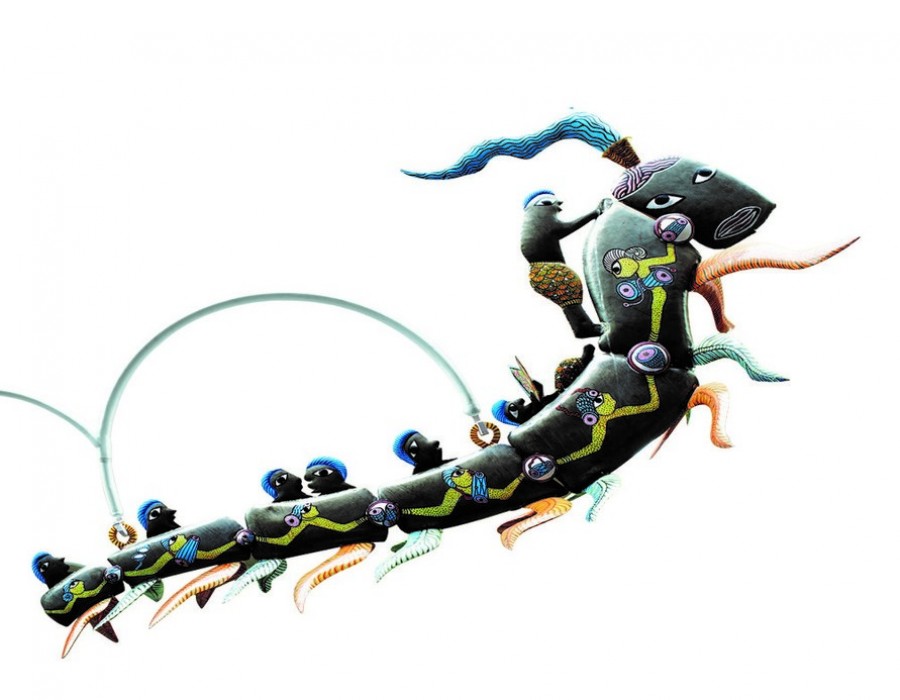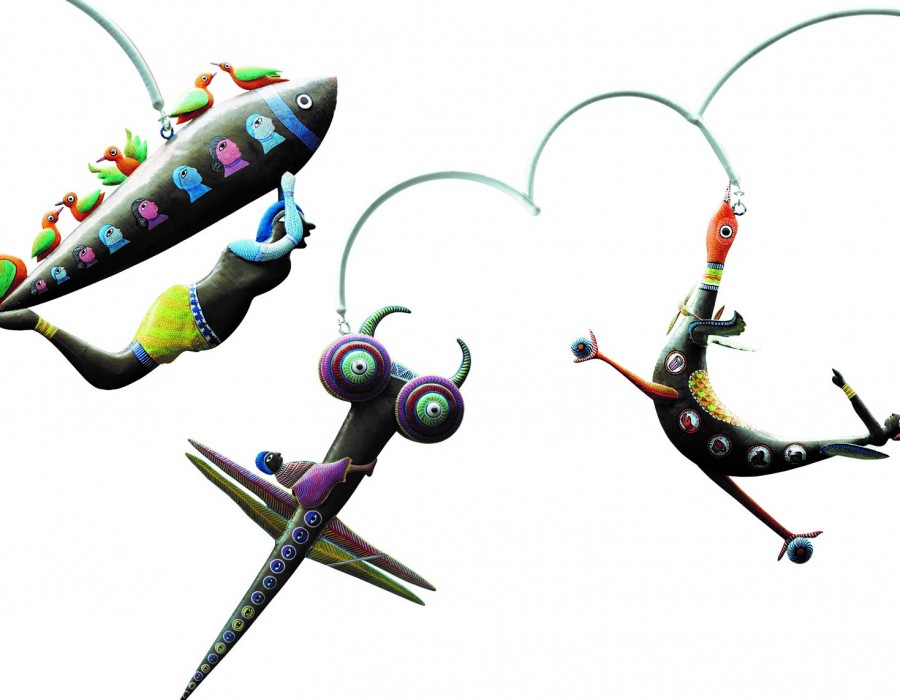WALKING TOWARDS BOARDING GATES. 43 & 44
Pays homage to both the journeys of the earthly body and the transcendental soul. This idea is articulated in various ways in India’s material culture and represents a larger philosophy of ever changing nature of man’s existence, one in constant state of flux, subject to the cyclical motions of kala or time.
‘India Moves’ is a scenographic portrayal of both the physical voyages that have charted India’s history and the concept of symbolic journey of the soul. These two ideas,over a period of time have become integral elements of Indian Culture and are practiced in its traditions and expressed in its arts and crafts. Thus, the age-old modes of transport like antique boats, bullock carts, elephant howdahs, wedding litters and palanquins, temple chariots and padukas that speak of modes of transport both mundane and festive, find expression as part of installations where boat heads and boats serenely float amid anachronistic schools of scrap-metal fish, and fantastical flying locomotives and mythical creatures are suspended in mid-flight from the ceiling above. A large stone relief depicts large ships bearing monks, merchants, and goods across tumultuous seas. The scenes and the style of the carving follow that of the 9 th century carvings of the Borobadur Temple in Java, the architecture and sculptural program of which reveal a strong Indian influence. This then pays homage to the concept of a Greater India and the shared histories with the rest of Asia.
FLYING LOCOMOTIVES
MUKUL GOYAL WITH GOND ARTISTS SUBHASH VYAM, DURGABAI VYAM, PRASAD KHUSHRAM AND RAM SINGH
Titled ‘The Flying Locomotives’, Mukul Goyal’s installation at the Mumbai International Airport consists of 10 sculptures suspended from the ceiling. The site-specific installation is poised 30 feet off the ground like an enormous mobile. Based on the theme of locomotion, transport, and flight. ‘The Flying Locomotives’ borrows from the repository of fantastical flying vehicles and creatures from Gond art, transforming them into three-dimensional mild steel sculptures.
“Given the unusual scale and sculptural quality required for this installation, simply selecting motifs from the vast visual vocabulary of the Gond tribal community would not have worked. The process began with repeated visits to the workshops of Gond artists in Bhopal during which we explored various possibilities, generating novel forms that drew on the tradition but were more suited to our requirements,” Goyal says.
Various new Gond motifs including a train shaped like a giant flying insect, an airborne elephant, flying geese, and the Hindu deity Hanuman depicted as though flying, evolved. These and other motifs created specifically for ‘The Flying Locomotive’ then had to be converted into three-dimensional sculptures, a particularly difficult task according to Goyal. “Gond art is made almost exclusively on a flat surface and hence, it has a particular linearity. Transforming this sensibility into three-dimensional or plastic forms was a unique challenge. ”
Working with the team of craftsmen at his factory, who are trained in the art of cutting, welding, polishing and embossing metalwork, Goyal united the various forms with a framework that resembles a skyline of clouds. “Since the forms are drawn from Gond art, the sculptures are truly indigenous and possess none of the influences of Western sculptural forms.”
The next challenge was to make this mobile sculpture of mammoth proportions kinetic. “An additional factor that had to be considered is that this work will be viewed from different levels at the airport lounge. Hence, the sculpture had to be well-rounded from all sides … Creating a static sculpture would have been easier but adding movement made it more interesting. Every time we had to add or subtract to the assemblage, it had to be done at a height that approximated the level at which it would be hung in the airport,” says Goyal.





